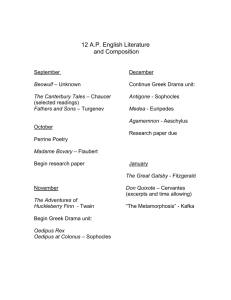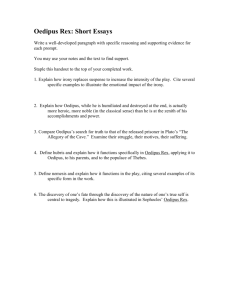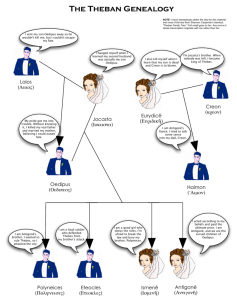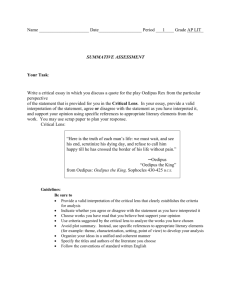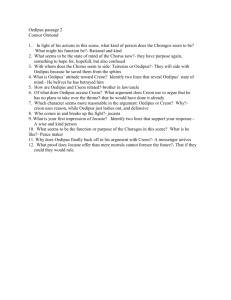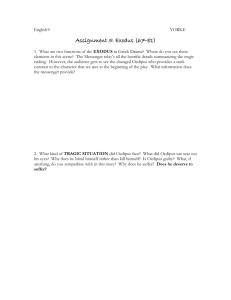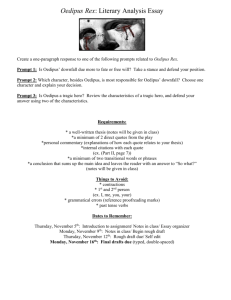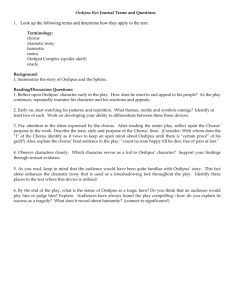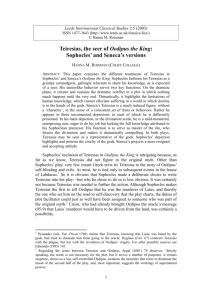Sophocles' Oedipus Rex Part One: Study Questions 1. 308: 13
advertisement
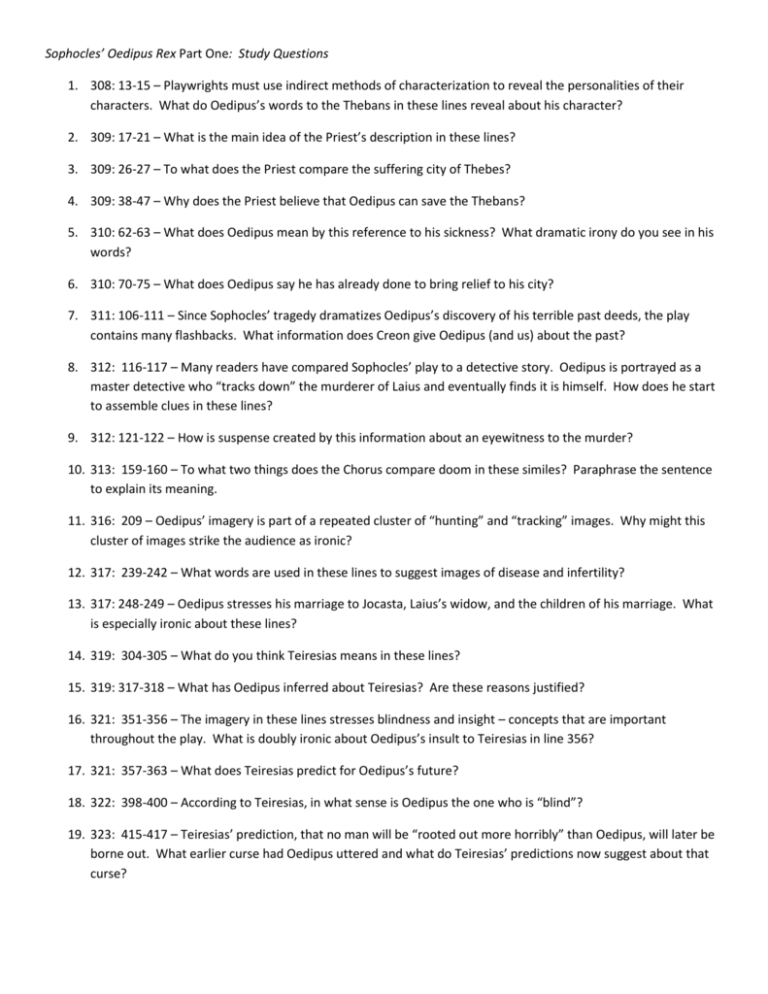
Sophocles’ Oedipus Rex Part One: Study Questions 1. 308: 13-15 – Playwrights must use indirect methods of characterization to reveal the personalities of their characters. What do Oedipus’s words to the Thebans in these lines reveal about his character? 2. 309: 17-21 – What is the main idea of the Priest’s description in these lines? 3. 309: 26-27 – To what does the Priest compare the suffering city of Thebes? 4. 309: 38-47 – Why does the Priest believe that Oedipus can save the Thebans? 5. 310: 62-63 – What does Oedipus mean by this reference to his sickness? What dramatic irony do you see in his words? 6. 310: 70-75 – What does Oedipus say he has already done to bring relief to his city? 7. 311: 106-111 – Since Sophocles’ tragedy dramatizes Oedipus’s discovery of his terrible past deeds, the play contains many flashbacks. What information does Creon give Oedipus (and us) about the past? 8. 312: 116-117 – Many readers have compared Sophocles’ play to a detective story. Oedipus is portrayed as a master detective who “tracks down” the murderer of Laius and eventually finds it is himself. How does he start to assemble clues in these lines? 9. 312: 121-122 – How is suspense created by this information about an eyewitness to the murder? 10. 313: 159-160 – To what two things does the Chorus compare doom in these similes? Paraphrase the sentence to explain its meaning. 11. 316: 209 – Oedipus’ imagery is part of a repeated cluster of “hunting” and “tracking” images. Why might this cluster of images strike the audience as ironic? 12. 317: 239-242 – What words are used in these lines to suggest images of disease and infertility? 13. 317: 248-249 – Oedipus stresses his marriage to Jocasta, Laius’s widow, and the children of his marriage. What is especially ironic about these lines? 14. 319: 304-305 – What do you think Teiresias means in these lines? 15. 319: 317-318 – What has Oedipus inferred about Teiresias? Are these reasons justified? 16. 321: 351-356 – The imagery in these lines stresses blindness and insight – concepts that are important throughout the play. What is doubly ironic about Oedipus’s insult to Teiresias in line 356? 17. 321: 357-363 – What does Teiresias predict for Oedipus’s future? 18. 322: 398-400 – According to Teiresias, in what sense is Oedipus the one who is “blind”? 19. 323: 415-417 – Teiresias’ prediction, that no man will be “rooted out more horribly” than Oedipus, will later be borne out. What earlier curse had Oedipus uttered and what do Teiresias’ predictions now suggest about that curse? 20. 323: 423-427 – Sophocles often uses subtle cues to develop the dialogue of the play. For example, Teiresias’ mention of Oedipus’ parents in line 324 suddenly causes Oedipus to shift gears and ask the prophet who his parents really were. Who does Oedipus believe are his parents? How does Teiresias counter his belief in line 425? What is ironic about Teiresias’ comment in line 427? 21. 324: 442-445 – What facts will the audience who knows the truth about Oedipus’ past, understand from Teiresias’ words in these lines? 22. 325: 469-475 – The Chorus refers to both an external and internal conflict. What possible external conflict does the Chorus mention but reject? Of what internal conflict in their minds is the Chorus beginning to be aware? 23. 325: 476-480 – How would you state the main idea of the Chorus in these lines? 24. 326: 497-504 – Sophocles directly characterizes both the Choragos and Creon through the dialogue. How would you characterize the Choragos from his words? What do Creon’s words imply about his personality? 25. 327: 506-511 – What character traits do Oedipus’s questions suggest? 26. 328: 540-541 – What is Oedipus’s reason for alleging that Teiresias must have conspired with Creon? Is this reasoning logical? 27. 328: 544-549 – The usual pattern in the question-and-answer dialogue of the play is reversed: Creon asks the questions, and then Oedipus answers them. What may Creon’s objective as he puts these questions to the king? 28. 329: 555-559 – Creon uses a form of argument that was popularized by the late fifth-century sophists, or professional teachers, in Athens: the so-called “argument from likelihood.” State Creon’s basic point in your own words. 29. 330: 603 – How does Jocasta personify the city of Thebes in this line? 30. 331: 623-629 – How would you describe the tone of these lines? What are some of the charged words and phrases that contribute to this tone? 31. 332: 651-654 – What extended comparison does the Choragos make? 32. 334-337: 669-681 and 730-772 – This scene includes two extensive flashbacks, the first by Jocasta and the second by Oedipus. What new information do we learn in lines 669-673? What is her purpose in giving Oedipus this information? Where does Oedipus say he grew up? What led him to question his parents about his birth? Why do you think Polybus and Merope lied? 33. 339: 829-833 – The imagery in these lines is compressed and complex. What are some of the different metaphors you can find that deal with tyranny?
